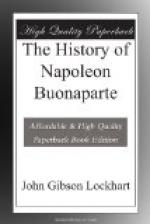After settling the affairs of Venice, and establishing the new Ligurian Republic, the general took up his residence at the noble castle of Montebello, near Milan. Here his wife, who, though they had been married in March, 1796, was still a bride, and with whom, during the intervening eventful months, he had kept up a correspondence full of the fervour, if not of the delicacy of love,[20] had at length rejoined him. Josephine’s manners were worthy, by universal admission, of the highest rank; and the elegance with which she did the honours of the castle, filled the ministers and princes, who were continually to be seen in its precincts, with admiration. While Napoleon conducted his negotiations with as much firmness and decision as had marked him in the field, it was her care that nature and art should lend all their graces to what the Italians soon learnt to call the Court of Montebello. Whatever talent Milan contained, was pressed into her service. Music and dance, and festival upon festival, seemed to occupy every hour. The beautiful lakes of Lombardy were covered with gay flotillas; and the voluptuous retreats around their shores received in succession new life and splendour from the presence of Napoleon, Josephine, and the brilliant circle amidst whom they were rehearsing the imperial parts that destiny had in reserve for them. Montebello was the centre from which Buonaparte, during the greater part of this autumn, negotiated with the emperor, controlled all Italy, and overawed the Luxembourg.
The final settlement with the emperor’s commissioners would have taken place shortly after the fall of Venice, but for the successful intrigues of the royalist Clichyens, the universal belief that the government of France approached some new crisis, and the Austrians’ hope that from such an event their negotiation might derive considerable advantages. Buonaparte well knew the secret motive which induced Cobentzel, the emperor’s chief envoy, to protract and multiply discussions of which he by this time was weary. One day, in this ambassador’s own chamber, Napoleon suddenly changed his demeanour; “you refuse to accept our ultimatum,” said he, taking in his hands a beautiful vase of porcelain, which stood on the mantelpiece near him. The Austrian bowed. “It is well,” said Napoleon, “but mark me—within two months I will shatter Austria like this potsherd.” So saying, he dashed the vase on the ground in a thousand pieces, and moved towards the door. Cobentzel followed him, and made submissions which induced him once more to resume his negotiations.
The result was the treaty of Campo-Formio, so-called from the village at which it was signed, on the 3d of October, 1797. By this act the emperor yielded to France, Flanders and the boundary of the Rhine, including the great fortress of Mentz. The various new republics of Lombardy were united and recognised under the general name of the Cisalpine Republic. To indemnify Austria for the loss of those territories,




